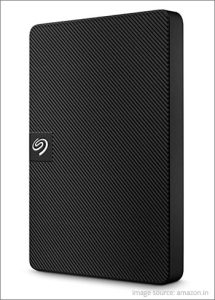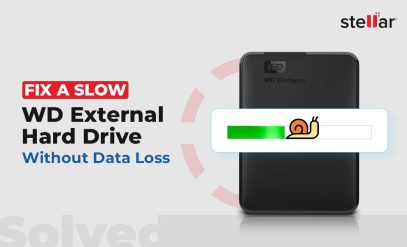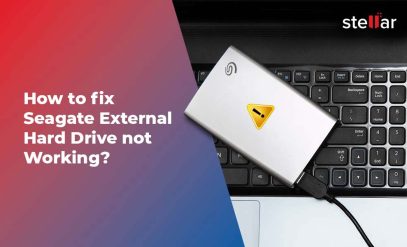Common Types of Problems with Seagate (External) Hard Drives
Several issues can cause data loss or prevent access to your Seagate external hard drive. Here are some of the most common problems we encounter:
1. Seagate External Hard Drive Not Showing Up
Often, this is due to a connection issue or a problem with the drive’s partition table, making the drive invisible to the operating system.
2. Seagate External Hard Drive Making Clicking Noises
This is usually a sign of mechanical failure, where the read/write head is unable to function properly, indicating severe physical damage.
Additional Reading: What to do if the hard disk makes noise?
3. Seagate External Hard Drive Detected but Data Inaccessible
This could result from file system corruption, where the drive’s directory structure is damaged, making data unreadable.
Additional Reading: Recover Data From Undetected Seagate External Hard Drive
4. Slow Performance and Frequent Freezes
These symptoms might indicate bad sectors on the disk, which can lead to data becoming inaccessible over time.
5. Data Disappears or Becomes Corrupted Without Explanation
This could be the result of malware or virus attacks, which can modify or delete files without the user’s knowledge.
If you experience any of these issues with your Seagate external hard drive, it’s crucial to seek expert help.
What are the Top Causes of Data Loss in Seagate External Hard Drives?
In cases involving Seagate’s external hard drive data recovery, data loss typically falls into two categories: physical and logical. Here are the top causes:
Physical Causes
- Impact Damage: Dropping or bumping your hard drive can lead to mechanical failures.
- Water Damage: Exposure to liquids can corrode internal components.
- Overheating: Insufficient cooling can cause parts to malfunction or degrade over time.
- Electrical Issues: Power surges can damage the electronic circuitry.
Logical Causes
- Corrupted Files: Incorrectly ejecting the drive or malware attacks can corrupt data.
- Accidental Deletion: Sometimes, crucial files are deleted by mistake.
- Partition Loss: Partitions can become corrupted, making data inaccessible.
What to Do If Data is Lost from Your Seagate HDD?
Data loss can be stressful, but taking the right steps (and avoiding the wrong ones!) can significantly increase your chances of recovery. Here’s what to do:
Immediately:
- Stop using the drive: Further use can overwrite deleted data, making recovery less likely.
- Listen for unusual noises: Clicking, grinding, etc., usually indicate a physical problem requiring professional help.
Don’t:
- Tinker with the drive: Opening the drive or attempting DIY fixes can worsen the issue.
- Let anyone open it in a non-clean room environment: Dust can damage the internal components.
Simple tips:
- Try a different cable/port: Rule out connection issues.
- Check on another computer: This can help determine if the problem is with the drive or your primary device.
- Consult a professional: Data recovery specialists have the tools and expertise for complex issues.
Client’s Challenge: Recovering Data from Seagate Hard Drive
Here’s a case study of how our team was able to recover data from a Seagate HDD. In this case, there were two problems with the drive: corrupted partition and bad sectors.
Problem:
The client initially noticed that their Seagate external hard drive wasn’t appearing on their computer, even though it seemed to be powered on. This meant they couldn’t access any of the files stored on the drive. The drive was visible in Device Manager, but the data inside wasn’t accessible.
This issue is different from the more common ‘Seagate external hard drive not showing up’ issue. For the client, despite trying different cables and systems, the drive remained visible but the data was inaccessible.
Diagnosis:
The Seagate external hard drive did not make any typical hard drive noises associated with a damaged drive. This is significant because different types of noises (clicking, grinding, beeping) can point toward specific internal physical failures within an external hard drive.
There was a risk of further data loss with each diagnostic step. To minimize this risk, we made the calculated decision to remove the external casing and directly connect the internal hard drive to our systems. This direct connection revealed that the drive’s partition was corrupted, preventing access to the stored data.
Steps for Recovering Data from Seagate:
The first step of the diagnosis was to conduct a thorough scan of the internal drive. This step revealed another problem: bad sectors on the drive. Despite these challenges, the scanning process successfully located the client’s essential data.
We proceeded cautiously with the following steps for this case of Seagate (external) hard drive data recovery:
- We created a full image (a copy) of the hard drive. This lets us work on the copy and avoid further potential damage.
- We used specialised software to repair the corrupted partition table and file system.
- We used techniques to either bypass damaged sectors or carefully remap them to healthy areas of the disk, maximising data recovery.
- We meticulously presented the recovered data to the client. This verification process confirms the success of the Seagate external hard drive data recovery process.
After discussing the client’s issue with the Seagate hard drive, let’s now explore top tips for preventing data loss.
Data Loss Prevention Top Tips
- Regular Backups – Frequently back up your data to another storage device or cloud service to prevent Seagate external hard drive lost data.
- Safe Ejection – Improper ejections over the long run can cause Seagate hard drive lost data. Always eject your Seagate external hard drive safely from the computer to avoid data corruption.
- Avoid Physical Damage – Keep your hard drive in a safe, stable place to prevent falls or bumps that could cause Seagate external hard drive lost data.
- Use Anti-Virus Software – Protect your Seagate HDD from malware and viruses that can corrupt data by using reliable anti-virus software.
- Power Surge Protection – Use a surge protector to shield your hard drive from unexpected power surges, which can cause Seagate external hard disk lost data.
Additional Reading: How To Recover Data From Seagate Barracuda 7200.12?
Frequently Asked Questions
1. Why Isn't My Seagate (External) Hard Drive Appearing on My Computer?
There could be several reasons, including corrupted partitions, file system damage, bad sectors, or physical problems.
2. Can Data Be Recovered from Unrecognized Seagate Hard Drives?
Yes, data recovery is often possible. Success depends on the specific issue and the expertise of the data recovery service.
3. Can files be recovered from a Seagate drive with bad sectors?
Yes, specialized tools and techniques can help recover data even in the presence of bad sectors.
4. Is it safe to attempt Seagate hard disk data loss recovery myself?
DIY attempts can worsen the problem. It’s best to consult professionals to avoid further data loss.
Additional Reading: Why to Choose Professional Data Recovery Services?
5. What's the success rate for Seagate HDD data recovery?
The success rate for Seagate HDD data recovery varies depending on factors like the extent of damage and professional expertise. Typically, reputable data recovery services boast high success rates in recovering data from Seagate drives.
6. Does my Seagate warranty cover data recovery services?
Seagate warranties generally do not cover data recovery services. They typically only cover hardware defects and replacements.
Additional Reading: Hard Drive Replacement in Warranty Period
7. Can Seagate External Drive Data Loss Occur Without Physical Damage?
Yes, Seagate external drive data loss can occur without physical damage. Factors such as software issues, file system corruption, or accidental deletion can lead to data loss.
8. How much does Seagate external hard drive data recovery cost?
The cost of Seagate external hard drive data recovery varies based on factors like the extent of damage and chosen service provider.
9. How to recover lost files from your Seagate drive?
You can recover lost files from your Seagate drive using data recovery software or by seeking professional assistance from data recovery services.
10. How can I prevent data loss on my Seagate External HDD?
Regularly back up your data to multiple locations (cloud, other drives), handle the drive with care, and use reliable surge protectors.








